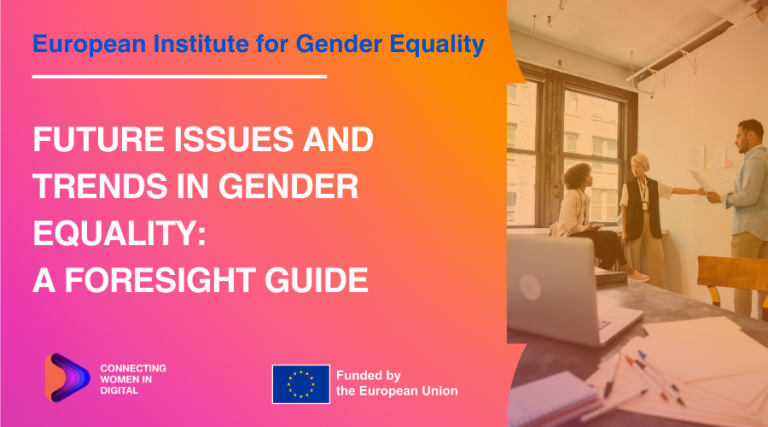In the ongoing pursuit of gender equality, a forward-looking perspective is both a strategic choice and a necessity. Understanding this imperative, The European Institute for Gender Equality (EIGE) has published a new foresight guide designed to help policymakers, researchers, activists, and other stakeholders proactively shape a more equitable future. Titled “Future issues and trends in gender equality: A foresight guide by EIGE“, this document serves as a comprehensive resource for integrating future thinking into the work of advancing gender equality.
The Power of Foresight
Foresight is a systematic approach to engaging with possible and desirable futures to inform present-day actions and decisions. Even with the most optimistic estimates, the journey toward full gender equality in the EU has a considerable path ahead. Foresight provides a powerful tool to address this urgency: by identifying and anticipating change, we can move from a reactive stance to a proactive one, equipping ourselves with the options needed to work toward desirable outcomes. This methodology intentionally considers multiple, alternative futures rather than attempting to predict a single one, which is crucial for developing robust strategies in an ever-changing world.
Historically, foresight has often been male and technology dominated and applied in a gender-blind manner. However, when implemented through a gender responsive lens, it offers unique opportunities to collectively envision and work toward just and equal futures. This is the core principle behind EIGE’s efforts to build foresight capacity, which includes a series of workshops and the publication of a policy brief on integrating gender considerations into EU foresight initiatives.
A Practical Tool for a Diverse Audience
The guide’s primary aim is to empower a diverse audience to conduct their own foresight exercises through a structured workshop. It connects academic futures studies, corporate strategic foresight and a more critical and feminist informed foresight tradition, offering practical tools and methods for a wide range of initiatives. The guide welcomes beginners, as it provides an ideal starting point without requiring any prior experience with foresight. It is also highly adaptable and can be tailored to specific contexts and needs, whether used as a standalone initiative or as an introduction to integrating foresight into existing activities.
The Workshop: A Step by Step Approach
The guide provides a detailed, four-hour workshop agenda based on widely used foresight approaches. The workshop is designed to be highly usable for a diverse range of stakeholders. It builds on five key issues that emerged from EIGE’s own foresight activities, which are available as a downloadable set of cards on their website.
The workshop is structured into three main working sessions (with a fourth optional session):
- Working Session 1: Prioritising future issues and trends – Participants engage with future issues and trends, mapping them based on their impact on gender equality and whether they are already being addressed. This step helps to prioritise topics for further exploration.
- Working Session 2: Understanding implications – Using a “futures wheel” method, participants brainstorm the direct and indirect consequences of prioritised trends on gender equality and their specific fields of work.
- Working Session 3: Exploring alternative pathways – This session encourages creative thinking by identifying potential disruptions and making implicit assumptions explicit. The goal is to explore how these factors could lead to alternative, more equitable futures.
- (Optional) Working Session 4: Sketching strategic actions – This session is for those with more time and is dedicated to connecting future-oriented thinking with present-day actions. Participants identify actions to promote desirable developments and actions that support preparedness for uncertain futures.
A Collaborative Path Forward
The workshop culminates in a plenary session where groups share their insights, fostering a joint perspective on relevant future developments and enabling a shared discussion. The guide emphasizes the importance of documenting these outcomes to ensure the insights can feed into strategic and innovation processes. EIGE’s guide is an invitation to engage in a collaborative and anticipatory process. It acknowledges that the future of gender equality is actively shaped by the decisions we make today. By providing these practical tools, EIGE aims to make equality between women and men a reality for all Europeans and beyond, ensuring that the trajectory towards equality is both intentional and inclusive.
We encourage our community to use this foresight guide to actively shape a more inclusive and equitable digital future.




